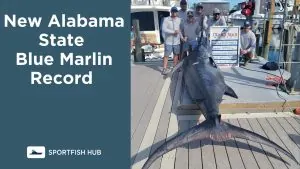If you’ve ever wondered, “Is marlin fishing catch and release?” you’re not alone. This topic is of growing concern to anglers around the world, especially with the increasing emphasis on conservation and sustainability.
Yes, marlin fishing is predominantly a catch-and-release practice. The sportfishing community has moved towards this method to preserve marlin populations and ensure the sustainability of the sport.
In this article, we will dive deep into the world of marlin fishing, with a specific focus on the catch-and-release aspect. We’ll look at why it’s critical for marlin conservation, the techniques involved in safe catch-and-release, and the role of regulations in enforcing this practice.
A Detailed Explanation of Catch-and-Release Marlin Fishing
Why Catch-and-Release is Essential in Marlin Fishing
The trend toward catch-and-release fishing is not random; a need for conservation drives it.
Marlin species, which include blue marlin, black marlin, and striped marlin, are among the most iconic big game fish.
However, they’re also threatened by overfishing and environmental changes. Catch-and-release fishing helps preserve these magnificent creatures, ensuring they live to fight another day and contribute to the sustainability of their population.
Recreational fishing, particularly the catch-and-release method, has been proven to have less impact on fish populations compared to commercial fishing. However, it’s essential to perform this practice correctly, as improper handling can still lead to the fish’s demise.
Techniques for Safe Catch-and-Release Marlin Fishing
Catch-and-release fishing involves certain techniques to minimize stress and injury to the fish, thus maximizing their survival chances upon release.
Use circle hooks instead of J-hooks, as they are less likely to cause fatal injuries. Ideally, these hooks should be non-stainless and barbless to facilitate their removal and eventual rusting out if left in the fish.
Fight the fish as quickly as possible to prevent exhaustion, which can make them vulnerable to predators after release. Always use a rod and reel that matches the size of the fish you’re targeting.
Once the marlin is at the boat, keep it in the water.
Use a de-hooking device to remove the hook safely. If you must handle the fish, wet your hands or gloves first to minimize damage to their protective slime coating. Always support the fish horizontally — never hold large fish vertically as this can injure their internal organs.
The Role of Regulations in Marlin Fishing
Regulations are crucial to ensure the practice of catch-and-release and the preservation of marlin populations. Various governing bodies like the International Game Fish Association (IGFA) and the Billfish Foundation have guidelines and rules on catch-and-release fishing.
Many places, including popular marlin fishing destinations, have implemented laws requiring catch-and-release practices for marlin fishing. For example, in Costa Rica and Guatemala, it is illegal to remove a billfish from the water, highlighting the importance of these practices in conservation efforts.
Conclusion
In conclusion, the practice of catch and release is crucial in marlin fishing to preserve the population and ensure the long-term sustainability of the sport. Marlin species are facing threats from overfishing and environmental changes, making responsible fishing practices essential for the future of Sportfishing.













